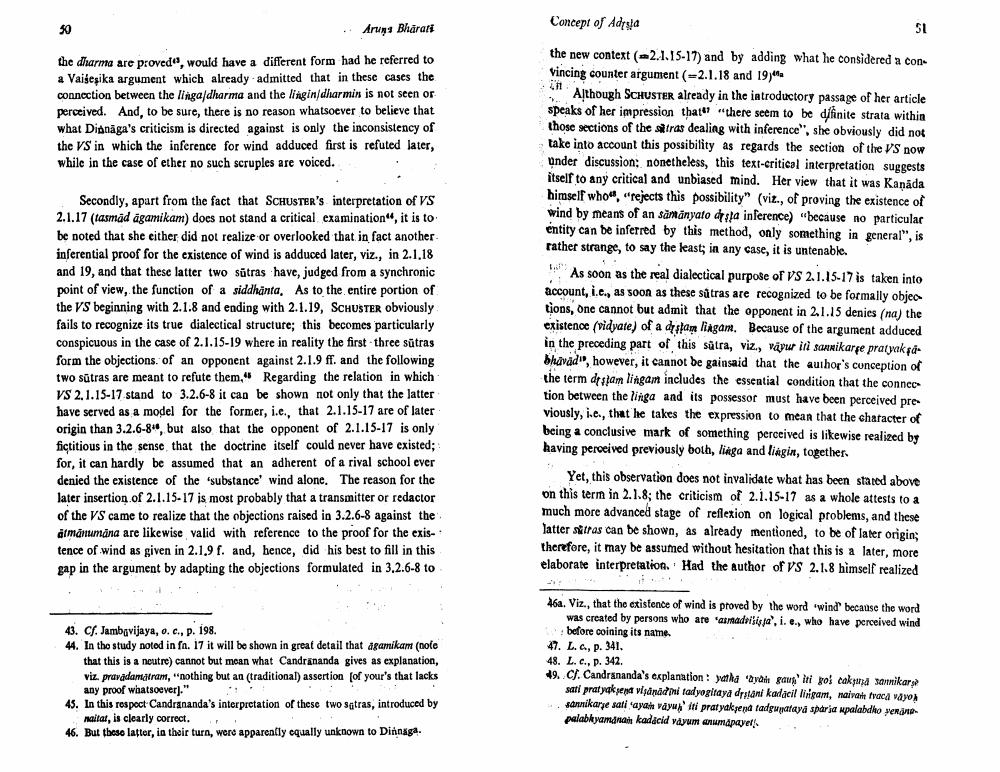Book Title: Note On Concept Adrsta As Used In Vaisesika Sutra Author(s): A Wezler Publisher: A Wezler View full book textPage 9
________________ 50 Aruns Bharati the dharma are proved", would have a different form had he referred to a Vaišeşika argument which already admitted that in these cases the connection between the linga/dharma and the lingin/dharmin is not seen or perceived. And, to be sure, there is no reason whatsoever to believe that what Dianaga's criticism is directed against is only the inconsistency of the VS in which the inference for wind adduced first is refuted later, while in the case of ether no such scruples are voiced. Secondly, apart from the fact that SCHUSTER's interpretation of VS 2.1.17 (tasmäd ägamikam) does not stand a critical examination", it is to be noted that she either did not realize or overlooked that in fact another inferential proof for the existence of wind is adduced later, viz., in 2.1.18 and 19, and that these latter two sūtras have, judged from a synchronic point of view, the function of a siddhänta. As to the entire portion of the VS beginning with 2.1.8 and ending with 2.1.19, SCHUSTER obviously fails to recognize its true dialectical structure; this becomes particularly conspicuous in the case of 2.1.15-19 where in reality the first three sutras form the objections. of an opponent against 2.1.9 ff. and the following two sutras are meant to refute them," Regarding the relation in which VS 2.1.15-17 stand to 3.2.6-8 it can be shown not only that the latter have served as a model for the former, i.e., that 2.1.15-17 are of later origin than 3.2.6-8, but also that the opponent of 2.1.15-17 is only fictitious in the sense that the doctrine itself could never have existed; for, it can hardly be assumed that an adherent of a rival school ever denied the existence of the substance' wind alone. The reason for the later insertion of 2.1.15-17 is most probably that a transmitter or redactor of the VS came to realize that the objections raised in 3.2.6-8 against the ātmānumāna are likewise valid with reference to the proof for the existence of wind as given in 2.1.9 f. and, hence, did his best to fill in this gap in the argument by adapting the objections formulated in 3.2.6-8 to 43. Cf. Jambavijaya, o. c., p. 198. 44. In the study noted in fa. 17 it will be shown in great detail that agamikam (note that this is a neutre) cannot but mean what Candrananda gives as explanation, viz. pravādamātram, "nothing but an (traditional) assertion [of your's that lacks any proof whatsoever]." 45. In this respect Candrananda's interpretation of these two satras, introduced by naitat, is clearly correct. r 46. But these latter, in their turn, were apparently equally unknown to Dinnaga. Concept of Adria the new context (2.1.15-17) and by adding what he considered a convincing counter argument (=2.1.18 and 19) n 51 Although SCHUSTER already in the introductory passage of her article speaks of her impression that "there seem to be dfinite strata within those sections of the satras dealing with inference", she obviously did not take into account this possibility as regards the section of the VS now under discussion: nonetheless, this text-critical interpretation suggests itself to any critical and unbiased mind. Her view that it was Kanāda himself who", "rejects this possibility" (viz., of proving the existence of wind by means of an samanyato desta inference) "because no particular entity can be inferred by this method, only something in general", is rather strange, to say the least; in any case, it is untenable. As soon as the real dialectical purpose of VS 2.1.15-17 is taken into account, i.e., as soon as these sutras are recognized to be formally objec tions, one cannot but admit that the opponent in 2.1.15 denies (na) the existence (vidyate) of a ditam lingam. Because of the argument adduced in the preceding part of this sutra, viz., vayur iti sannikarse pratyakşa bhavad, however, it cannot be gainsaid that the author's conception of the term drstam lingam includes the essential condition that the connec tion between the linga and its possessor must have been perceived previously, i.e., that he takes the expression to mean that the character of being a conclusive mark of something perceived is likewise realized by having perceived previously both, liaga and lingin, together. Yet, this observation does not invalidate what has been stated above on this term in 2.1.8; the criticism of 2.1.15-17 as a whole attests to a much more advanced stage of reflexion on logical problems, and these latter stras can be shown, as already mentioned, to be of later origin; therefore, it may be assumed without hesitation that this is a later, more elaborate interpretation. Had the author of VS 2.1.8 himself realized 46a. Viz., that the existence of wind is proved by the word "wind" because the word was created by persons who are asmadrisisja", i. e., who have perceived wind before coining its name. 47. L. c., p. 341. 48. L. c., p. 342. 49. Cf. Candrananda's explanation: yatha byai gaus iti goi caka sannikars sati pratyakşeṇa viṣāṇādini tadyogitaya drstani kadacil lingam, naivan traca vayoḥ sannikarze sati ayah vayu iti pratyaksena tadguyataya spárja upalabdho yemanapalabkyamanan kadacid vayum anumapayetlPage Navigation
1 ... 7 8 9 10 11 12 13
